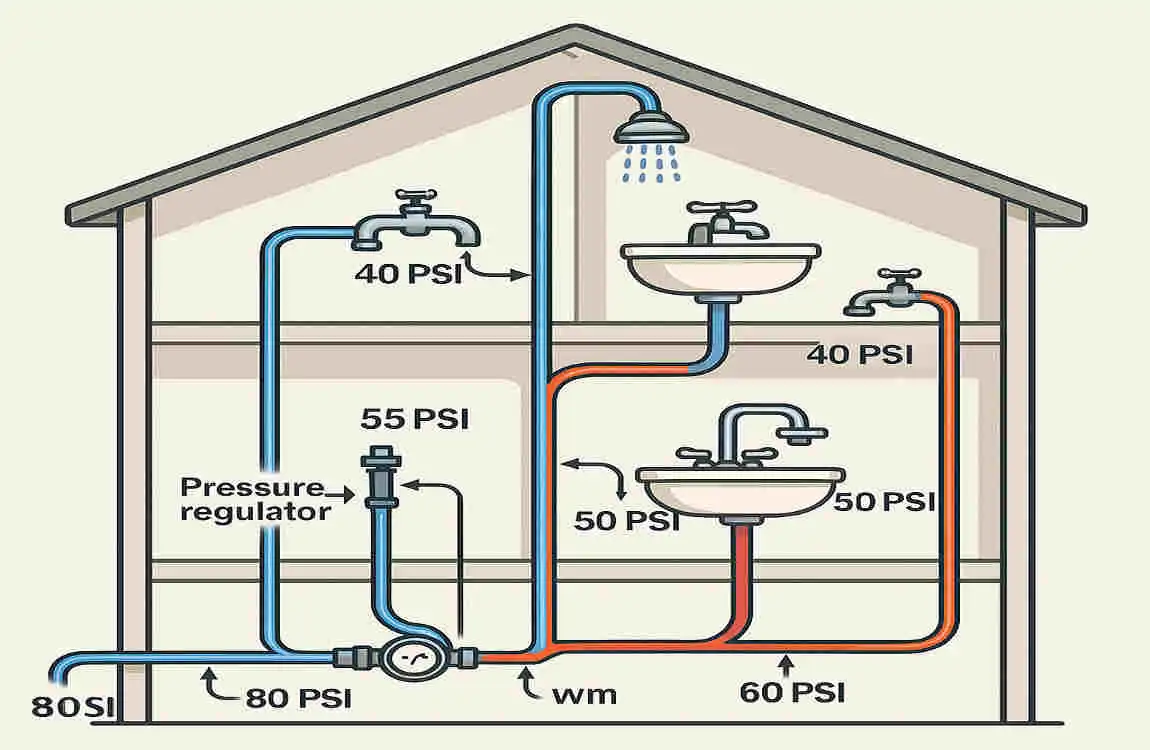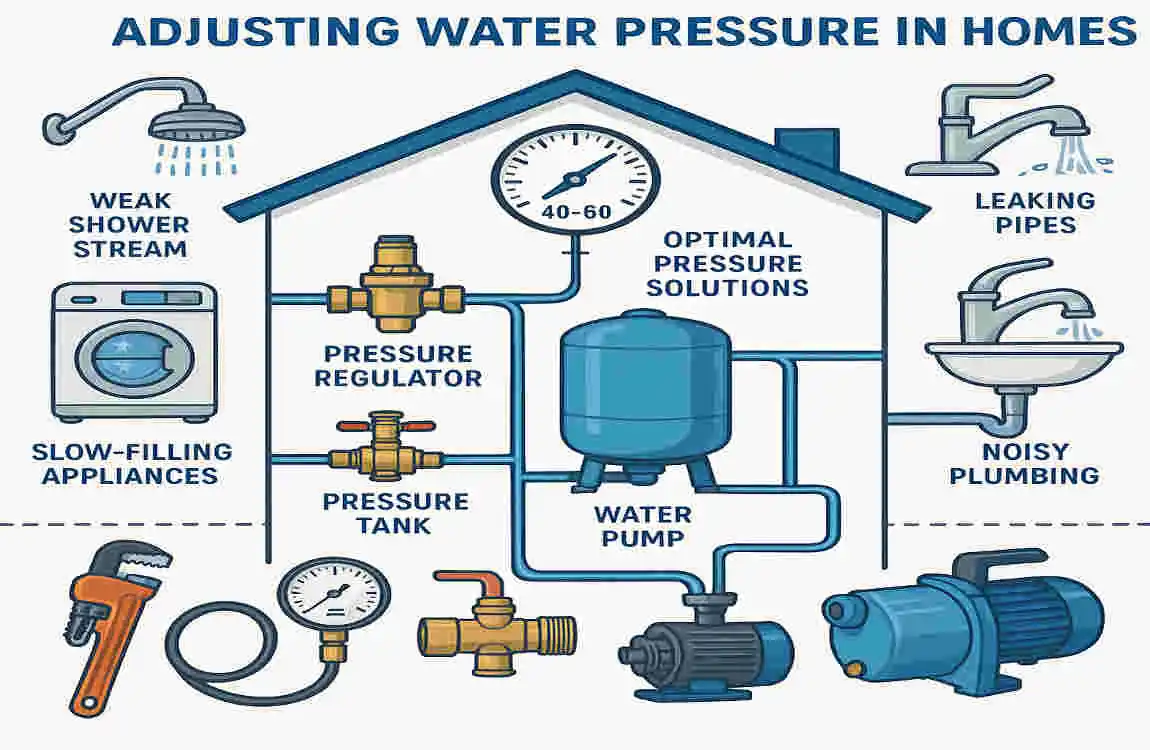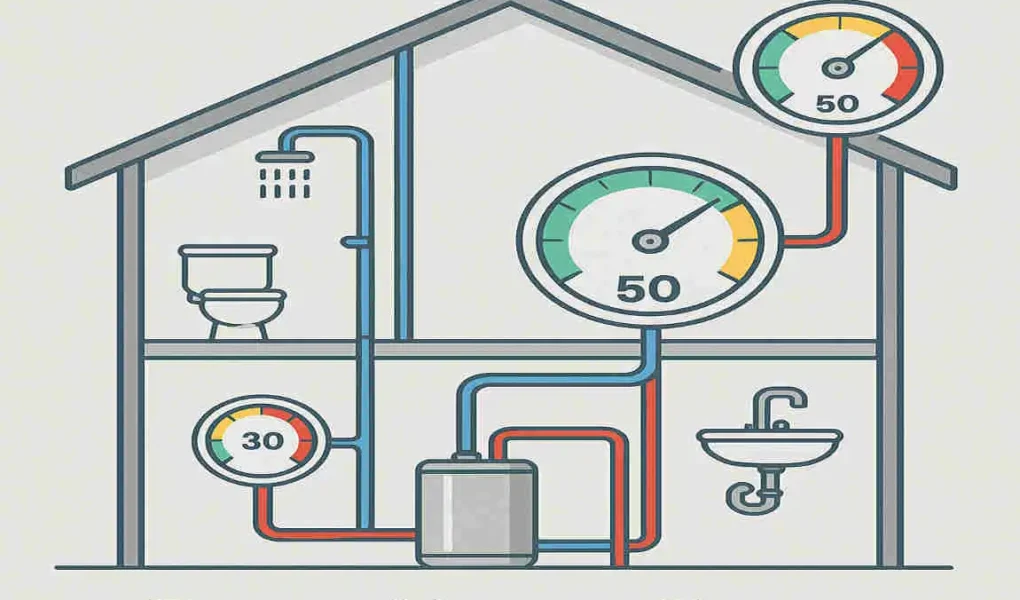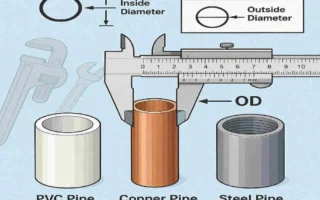The optimal water pressure for house plumbing in 2025 is typically between 40 and 60 pounds per square inch (psi), with most experts recommending around 60 psi as the perfect balance. This range ensures sufficient water flow for comfortable showers and efficient appliance operation while protecting your plumbing system from damage caused by excessive pressure. Pressure below 40 psi may lead to weak water flow, while pressure above 80 psi risks causing leaks and pipe bursts.
What Is Water Pressure and Why Does It Matter?
Defining Water Pressure in Plumbing Systems
Water pressure is the force that pushes water through your pipes and out of your faucets. It’s what gives you that satisfying stream when you turn on the tap or step into the shower. In plumbing terms, water pressure is measured in pounds per square inch (PSI).
How Water Pressure Affects Plumbing Fixture Performance
The correct water pressure is crucial for your plumbing fixtures to function at their best. With optimal pressure, your showerheads will provide a refreshing spray, your faucets will deliver a steady stream, and your toilets will flush efficiently. But if the pressure is too low or too high, you might experience weak flows, uneven sprays, or even leaks and damage.
The Role of Water Pressure in Daily Household Activities
Think about all the ways you use water in your home every day. From brushing your teeth to washing dishes, water pressure plays a vital role in making these tasks smooth and efficient. With the correct pressure, your showers will be invigorating, your laundry will get cleaner faster, and your appliances will perform at peak efficiency.
Problems Caused by Low or High Water Pressure
But what happens when your water pressure is off? If it’s too low, you might find yourself waiting forever for the tub to fill or struggling with a weak shower stream. On the other hand, if the pressure is too high, you could be dealing with noisy pipes, dripping faucets, and even damaged seals and leaks. That’s why finding the sweet spot is so crucial for your home’s plumbing health.
Understanding PSI in House Plumbing

What Is PSI and How Is It Measured?
PSI, or pounds per square inch, is the unit used to measure water pressure in your home’s plumbing system. It represents the force of water pushing against the walls of your pipes. To measure PSI, you’ll need a water pressure gauge, which we’ll discuss later.
Typical Water Pressure Ranges Found in Residential Homes
In most residential homes, you’ll find water pressure ranging from 30 to 80 PSI. However, the ideal range for safe, efficient plumbing is typically 40-60 PSI. This range provides enough force for your fixtures to function properly without straining your pipes.
Units Commonly Used and How to Convert Between Them (PSI, Bar)
While PSI is the most common unit for measuring water pressure in the United States, you might encounter other units, such as bar or kPa (kilopascals), in other parts of the world. To convert between these units, you can use the following formulas:
- 1 PSI = 0.0689476 bar
- 1 bar = 14.5038 PSI
Tools Needed to Measure Your Home Water Pressure
To measure your home’s water pressure, you’ll need a water pressure gauge. These handy devices can be attached to an outdoor hose bib or a faucet inside your home. We’ll go into more detail about how to use a pressure gauge later in this guide.
Recommended Water Pressure Range for Homes in 2025
Standard Recommended PSI Range for Safe and Efficient Plumbing (40-60 PSI)
As we mentioned earlier, the sweet spot for water pressure in most homes is between 40 and 60 PSI. This range provides enough force to keep your fixtures flowing well while minimizing the risk of damage to your pipes and appliances.
Why Too Low (<40 PSI) or Too High (>80 PSI) Water Pressure Is Problematic
If your water pressure falls below 40 PSI, you might notice weak flow, slow-filling tubs, and longer appliance run times. On the other hand, if your pressure exceeds 80 PSI, you could be dealing with noisy pipes, dripping faucets, and even leaks or burst pipes.
How 2025 Plumbing Trends and New Fixtures May Influence Ideal Pressure Levels
As we move into 2025, new plumbing trends and fixtures are emerging that may impact the ideal pressure levels for your home. For example, eco-friendly fixtures designed for lower water usage might perform best at the lower end of the recommended range (around 40-50 PSI). On the other hand, high-performance showerheads and faucets require pressure closer to 60 PSI to function at their best.
Comparing Municipal Water Systems and Private Wells — Impact on PSI
The source of your water can also affect the pressure in your home. If you’re connected to a municipal water system, your pressure will be influenced by the city’s water supply and the distance from the main water line to your home. On the other hand, if you have a private well, your pressure will depend on factors like the well’s depth, the pump’s capacity, and the size of your pressure tank.
Factors Affecting Water Pressure in Your Home
Size and Design of Your Plumbing System
The size and layout of your home’s plumbing system can significantly affect your water pressure. If you have a large house with many fixtures and appliances, you might need a more robust plumbing system to maintain consistent pressure throughout. On the other hand, a smaller home with fewer fixtures could get by with a more straightforward setup.
Distance from the Municipal Water Source or Water Well
The farther your home is from the municipal water source or your private well, the more pressure you might lose along the way. This is especially true if your pipes are old or undersized. If you live at the end of a long water line, consider installing a booster pump to maintain adequate pressure.
Elevation Differences and Gravity Impact
Gravity can also affect your home’s water pressure. If your house is on a hill or has multiple stories, you might experience lower pressure on the upper floors due to the added height the water needs to travel. In these cases, a pressure booster pump or a larger water supply pipe might be necessary to maintain consistent pressure throughout your home.
Water Supply Pipe Diameter and Material
The size and material of your water supply pipes can also affect your home’s pressure. Larger pipes can handle higher water flow and maintain higher pressure, while smaller pipes might restrict flow and result in lower pressure. Additionally, the type of pipe material (such as copper, PEX, or PVC) can impact the flow rate and pressure loss over distance.
Pressure Regulators and Booster Pumps
To help manage your home’s water pressure, consider installing a pressure regulator or a booster pump. A pressure regulator can help reduce high incoming pressure from the municipal water system. At the same time, a booster pump can increase low pressure from a private well or a distant water source. We’ll talk more about these solutions later in this guide.
Signs You Have Incorrect Water Pressure
Symptoms of Low Water Pressure: Weak Flow, Inconveniences, Extended Appliance Run Times
If your home’s water pressure is too low, you’ll likely notice some telltale signs. You might notice weak water flow from your faucets and showerheads, making it harder to wash dishes or take a refreshing shower. It may also take longer to fill the bathtub or run your appliances, such as the washing machine or dishwasher.
Overpressure Signs: Noisy Pipes, Dripping Faucets, Damaged Seals, Frequent Plumbing Repairs
On the other hand, if your water pressure is too high, you might hear some unusual noises coming from your pipes. You could also notice dripping faucets or leaking toilets, even when they’re turned off. Over time, high pressure can cause damage to your pipes, fittings, and appliance seals, leading to more frequent plumbing repairs and replacements.
How to Diagnose Water Pressure Issues Yourself Before Calling a Plumber
Before you call in a professional, there are a few simple steps you can take to diagnose water pressure issues in your home. Start by checking all your faucets and fixtures to see if the low pressure is consistent throughout the house. If it’s affecting only one or two fixtures, the problem might be localized to those areas.
You can also try running multiple fixtures at once to see if the pressure drops significantly. If it does, you might have a problem with your main water supply or a clogged pipe. Finally, you can use a water pressure gauge (which we’ll discuss in the next section) to get a more accurate reading of your home’s pressure.
How to Measure Water Pressure in Your Home
Step-by-Step Guide to Using a Water Pressure Gauge
Measuring your home’s water pressure is easier than you might think. All you need is a water pressure gauge, which you can find at most hardware stores or online. Here’s a simple step-by-step guide to get you started:
- Locate a Hose Bib or Faucet: Find an outdoor hose bib or an indoor faucet that’s close to your main water supply line. Make sure it’s easily accessible and has enough space to attach the pressure gauge.
- Attach the Pressure Gauge: Screw the pressure gauge onto the hose bib or faucet, making sure it’s securely attached and won’t leak.
- Turn on the Water: Slowly turn on the water to the hose bib or faucet, allowing the pressure to build up in the gauge.
- Read the Gauge: Once the pressure has stabilized, read the PSI value on the indicator. This will give you an accurate measurement of your home’s water pressure.
- Turn Off the Water and Remove the Gauge: When you’re done, turn off the water and carefully remove the pressure gauge from the hose bib or faucet.
Ideal Spots to Measure Pressure (Outdoor Hose Bib, Near the Main Supply Line)
The best spots to measure your home’s water pressure are usually an outdoor hose bib or a faucet near your main water supply line. These locations provide a direct connection to your home’s water system and give you an accurate reading of the pressure entering your home.
Frequency of Testing Water Pressure for Maintenance
To keep your home’s plumbing system running smoothly, it’s a good idea to test your water pressure at least once a year. This will help you catch any changes or issues early on and make adjustments as needed. If you notice any sudden changes in your water pressure or start experiencing problems with your fixtures, it’s a good idea to test it more frequently until the issue is resolved.
Solutions for Adjusting and Optimizing Water Pressure

Installing or Adjusting a Pressure Regulator Valve
If your home’s water pressure is too high, installing or adjusting a pressure regulator valve can help bring it down to a safe and efficient level. A pressure regulator is typically installed near your main water supply line and can be adjusted to reduce the incoming pressure to your home.
To Install a pressure regulator, you’ll need to hire a licensed plumber who can properly size and Install the valve for your specific plumbing system. Once it’s in place, you can adjust the pressure to the desired level, usually between 40 and 60 PSI.
Using a Booster Pump for Low-Pressure Scenarios
If your home’s water pressure is too low, a booster pump can increase it to a more usable level. A booster pump is typically installed near your main water supply line and can be set to activate when the pressure falls below a certain threshold.
Like a pressure regulator, a booster pump should be installed by a licensed plumber who can properly size and configure the pump for your specific needs. Once it’s in place, you’ll enjoy higher water pressure throughout your home, making it easier to use your fixtures and appliances.
Pressure Reducing Valve for Areas with High Municipal Water Pressure
If you live in an area with high municipal water pressure, a pressure-reducing valve can help protect your home’s plumbing system from damage. A pressure-reducing valve is similar to a pressure regulator but is specifically designed to handle high incoming pressure from the city water supply.
Like other pressure management devices, a pressure-reducing valve should be installed by a licensed plumber who can properly size and configure it for your specific needs. Once it’s in place, you’ll enjoy safer and more consistent water pressure throughout your home.
Routine Maintenance Tips to Prevent Pressure Fluctuations
To keep your home’s water pressure stable and prevent fluctuations, it’s essential to maintain your plumbing system regularly. Here are a few tips to keep in mind:
- Check for Leaks: Regularly inspect your pipes, fittings, and fixtures for any signs of leaks or drips. Even minor leaks can cause gradual pressure drops.
- Clean Your Aerators: The aerators on your faucets can become clogged with mineral buildup over time, reducing water flow and pressure. Remove and clean them regularly to keep your faucets flowing freely.
- Flush Your Water Heater: If you have a tank-style water heater, flushing it annually can help remove sediment buildup that can restrict water flow and pressure.
- Insulate Your Pipes: In cold climates, insulating your pipes can help prevent them from freezing and bursting, which can cause sudden pressure drops.
When to Call a Professional Plumber
While many water pressure issues can be diagnosed and resolved by homeowners, there are times when it’s best to call in a professional plumber. If you’re unsure about the cause of your pressure problems or if you need to Install or adjust a pressure management device, a licensed plumber can provide expert guidance and assistance.
Additionally, if you notice any signs of major leaks, burst pipes, or other serious plumbing issues, don’t hesitate to call a plumber right away. They can help diagnose the problem and make the necessary repairs to get your water pressure back to normal.
Impact of Optimal Water Pressure on Plumbing Longevity and Water Conservation
How Correct Water Pressure Extends the Lifespan of Pipes and Fixtures
Maintaining the correct water pressure in your home can significantly extend the lifespan of your pipes and fixtures. When your pressure is too high, it can put unnecessary strain on your plumbing system, leading to leaks, bursts, and premature wear and tear.
By keeping your pressure within the recommended range of 40 to 60 PSI, you can help extend the lifespan of your pipes and fixtures. This means fewer repairs and replacements over time, saving you money and hassle in the long run.
Reducing Leaks and Water Waste by Managing Pressure Properly
Proper water pressure management can also help reduce leaks and water waste in your home. When your pressure is too high, it can cause small leaks to develop in your pipes, fittings, and fixtures. Over time, these leaks can add up, wasting gallons of water and driving up your utility bills.
By keeping your pressure at the right level, you can minimize the risk of leaks and reduce water waste. This not only helps the environment but also saves you money on your water bills.
Lower Energy Bills by Optimizing Water Flow for Appliances (Water Heaters, Washing Machines)
Optimizing your home’s water pressure can also help lower your energy bills by improving the efficiency of your appliances. When your pressure is too low, your water heater, washing machine, and other appliances need to work harder to maintain proper water flow, using more energy in the process.
By keeping your pressure within the recommended range, you can help your appliances operate at peak efficiency, use less energy, and save you money on your utility bills. It’s a win-win for your wallet and the environment!
Latest Plumbing Innovations Influencing Water Pressure Management (2025)
Smart Pressure Monitoring Systems and IoT Devices
As we move into 2025, smart pressure monitoring systems and IoT (Internet of Things) devices are becoming increasingly popular for managing home water pressure. These innovative technologies allow you to monitor your water pressure in real-time, alerting you to any changes or issues before they become significant problems.
With an innovative pressure-monitoring system, you can keep an eye on your home’s water pressure from your smartphone or tablet, making it easier to detect and address issues quickly. Some systems even allow you to remotely adjust your pressure settings or schedule maintenance tasks, giving you more control over your plumbing system than ever before.
Advanced Pressure Regulation Technology
In addition to innovative monitoring systems, advanced pressure regulation technology is also making waves in the plumbing industry. New pressure regulators and valves are being designed with more precise control and better durability, helping to maintain consistent water pressure throughout your home.
Some of these advanced regulators even feature built-in diagnostics and self-adjusting capabilities, making it easier to keep your pressure at the perfect level without constant manual adjustments. With these innovations, you can enjoy more reliable and efficient water pressure management in your home.
Eco-Friendly Fixtures Designed for Optimal Pressure Use
As sustainability becomes a bigger priority for homeowners, eco-friendly fixtures designed for optimal pressure use are gaining popularity. These innovative fixtures, such as low-flow showerheads and faucets, are designed to operate efficiently at lower water pressure, helping conserve water and reduce waste.
By installing eco-friendly fixtures in your home, you can enjoy optimal water pressure while also doing your part for the environment. These fixtures can help you save water and lower your utility bills, while maintaining a comfortable, enjoyable water flow.




